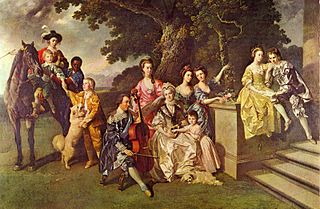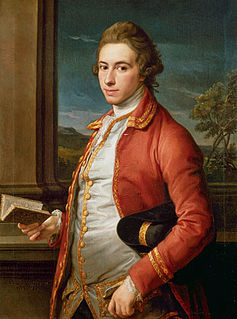
Earl of Winchilsea is a title in the Peerage of England held by the Finch-Hatton family. It has been united with the title of Earl of Nottingham under a single holder since 1729. The Finch family is believed to be descended from Henry FitzHerbert, Lord Chamberlain to Henry I. The name change to Finch came in the 1350s after marriage to an heiress by a member of the Finch family. In 1660 the 3rd Earl of Winchilsea was created Baron FitzHerbert of Eastwell, Kent, in recompense for his efficient aid in the Restoration of the Monarchy. The Herbert family of Wales, Earls of Pembroke, share common ancestry but bear differenced arms. A later member of the family, Sir William Finch, was knighted in 1513. His son Sir Thomas Finch, was also knighted for his share in suppressing Sir Thomas Wyatt's insurrection against Queen Mary I, and was the son-in-law of Sir Thomas Moyle, some of whose lands Finch's wife inherited. Thomas's eldest son Moyle Finch represented Weymouth, Kent and Winchelsea in the House of Commons. In 1611 he was created a baronet, of Eastwell in the County of Kent.

Baron Waterpark of Waterpark in the County of Cork, is a title in the Peerage of Ireland. It was created in 1792 for Sarah, Lady Cavendish, in honour of her husband, Sir Henry Cavendish, 2nd Baronet. Sir Henry Cavendish was a politician who represented Lismore and Killybegs in the Irish House of Commons and served as Vice-Treasurer of Ireland and as Receiver-General of Ireland. From 1768 to 1774 he sat in the British House of Commons for Lostwithiel. Cavendish and Lady Waterpark were both succeeded by their son Richard, the second Baron and third Baronet. His eldest son, the third Baron, represented Knaresborough, Derbyshire South and Lichfield in the House of Commons as a Liberal and served as a Lord-in-waiting under Lord John Russell, Lord Aberdeen and Lord Palmerston. This line of the family failed on the death of his grandson, the fifth Baron, in 1932. The late Baron was succeeded by his second cousin, the sixth Baron. He was the grandson of a younger son of the second Baron. As of 2022, the titles are held by the latter's great-nephew, the eighth Baron, who succeeded in 2013.

There have been two baronetcies created for members of the Hanmer family of Flintshire, Wales, one in the Baronetage of England and one in the Baronetage of Great Britain. Only one creation is extant as of 2008. The third Baronet of the second creation was elevated to the peerage as Baron Hanmer in 1872, a title which became extinct in 1881. The family name derived from the manor of Hanmer in the Diocese of St. Asaph.

There have been two baronetcies created for persons with the surname Aylmer, both in the Baronetage of Ireland. Both titles are extant.

There have been five baronetcies created for persons with the surname Young, one in the Baronetage of England, one in the Baronetage of Great Britain and three in the Baronetage of the United Kingdom. As of 2014, four of the creations are extant.

The Chaytor family is an English gentry family on which has been conferred two baronetcies, one in the Baronetage of England and one in the Baronetage of the United Kingdom and several knighthoods. As of 2008 one baronetcy is extinct.

There have been three baronetcies created for members of the Vernon family.
There have been three baronetcies created for members of the Mosley family, one in the Baronetage of England and two in the Baronetage of Great Britain. Only one creation is extant. Since 1980, the title has been held jointly with Baron Ravensdale in the Peerage of the United Kingdom.
There have been four baronetcies created for persons with the surname Temple, two in the Baronetage of England, one in the Baronetage of Nova Scotia and one in the Baronetage of the United Kingdom.

Tissington Hall is an early 17th-century Jacobean mansion house in Tissington, near Ashbourne, Derbyshire. It is a Grade II* listed building.

Norbury Manor is a 15th-century Elizabethan manor house and the adjoining 13th-century stone-built medieval Norbury Hall, known as The Old Manor in Norbury near Ashbourne, Derbyshire. It is a Grade I listed building.

The Baronetcy of Gresley of Drakelow was created in the Baronetage of England on 29 June 1611 for George Gresley of Drakelow Hall, Derbyshire who was later High Sheriff of Derbyshire and Member of Parliament for Newcastle-under-Lyme.
There have been two baronetcies created for members of the Wolseley family, one in the Baronetage of England and one in the Baronetage of Ireland. As of 2018 the Wolseley Baronetcy of Mount Wolseley is dormant.
There have been three baronetcies created for persons with the surname Osborne, two in the baronetage of England and one in the baronetage of Ireland. Two creations are extant.
The Sheriff of Nottinghamshire, Derbyshire and the Royal Forests is a position established by the Normans in England.
The Vernon family was a wealthy, prolific and widespread English family with 11th-century origins in Vernon, Normandy, France. Their extant titles include Baron Vernon and Vernon baronets of Shotwick Park.

Sir William FitzHerbert, 1st Baronet (1748–1791) was the first baronet Fitzherbert of Tissington. He was a lawyer and recorder for Derby. He was an usher to King George III. He owned a number of plantations for sugar and coffee in Jamaica and Barbados.
Sir Henry Osborne, 11th Baronet, was an Irish baronet and politician.

Thomas Cromwell, 1st Earl of Ardglass, 11 June 1594 to 20 November 1653, was an English nobleman, son of Edward Cromwell, 3rd Baron Cromwell and his second wife Frances Rugge.

Sir Richard Ranulph FitzHerbert, 9th Baronet, is a British landowner and holds the FitzHerbert baronetcy, which he inherited in 1989 along with the family home, Tissington Hall, on the death of his uncle, Sir John FitzHerbert. At the time of his inheritance, he was working as a wine merchant.














